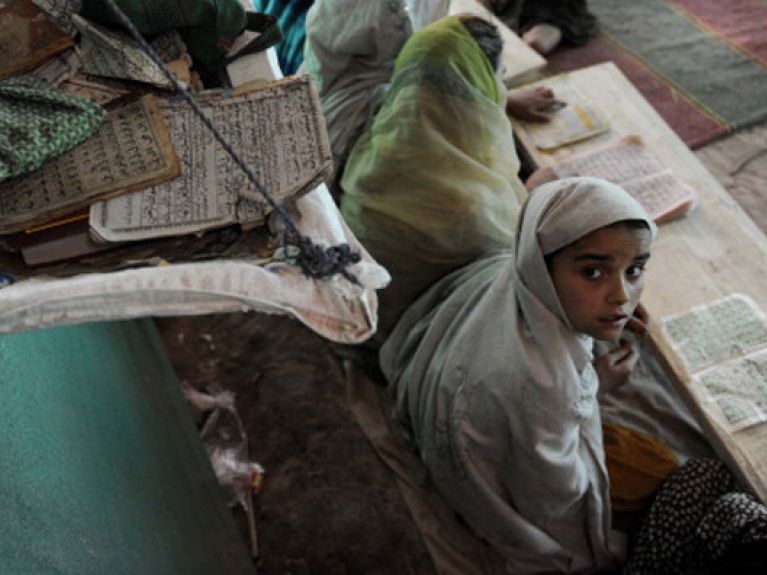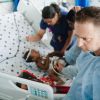Network for development
The EU is the largest development assistance donor worldwide. The Commission and the member states are increasingly coordinating their efforts in this regard.

Great was the public outcry when, back in April 2013, the Rana Plaza building just outside Dhaka collapsed and 1,127 people lost their lives, most of them workers in textile factories. At the time, some European countries were already busy developing labelling obligations for imported clothing. But how does it help seamstresses in Bangladesh if individual governments insist on adherence to certain social standards? Since then, the European Commission and several member states have been working to launch a pan-European initiative.
In February 2013, European development cooperation with Mali recommenced after the authorities in Mali agreed a transitional road map to restore democracy and stability. Since then, the focus has been on long-term projects to achieve food security and provide access to clean water and sanitary facilities as well as proposals for rebooting the African country’s economy. The EU organised a large international donor conference in Brussels, and the participants promised to provide 3.25 billion euros to support development in Mali.
These are just two recent examples of European development cooperation proving its value in offering broad policy support and considerable financial resources. Europe is the single largest donor of public funds for development cooperation. In 2013, European institutions and the 28 member states contributed no less than 56.5 billion euros and thus some 60% of the total made available worldwide for development.
Europe’s path to becoming a global actor in the field of development cooperation also took it to Monterrey in Mexico. This was where the international community met in 2002 for a United Nations (UN) conference to discuss way of funding the Millennium Development Goals. One of the results was that the EU member states committed to providing more funding for development cooperation. Three years later, the EU reached another milestone in the form of the “European Consensus” between the Council, Commission and Parliament. For the first time, Europe formulated common principles for development policy. The EU’s most important objective is to reduce poverty in the developing countries, and it has a broad range of instruments with which it assists partner countries in reaching this goal. The emphasis is on “help for self-help”. The involvement of civil society is also an important principle. The member states agreed to contribute 0.7% of gross national product for global assistance by 2015, thus reaffirming the target set by the UN in 1970.
The European External Action Service (EEAS) is responsible for the multi-year programming of development funding, while the EuropeAid Directorate General is in charge of implementation. The EU has long since gained a reputation as a reliable partner given its approach to development cooperation. “We are considered an objective, interest-free donor because we require the approval of all member states for each programme,” explains Klaus Rudischhauser, Deputy Director-General of EuropeAid. There is a drawback to this joint approach: the bureaucracy. Frequently, people say that everything takes longer at the EU than with other donors. Rudischhauser can understand the criticism, but explains: “EU budget guidelines are exceptionally strict. In addition, approvals take longer here, which means we are a little less flexible.”
The EU does not have a development agency of its own, but appoints international and national public- and private-sector organisations to implement its projects – for example, Germany’s Deutsche Gesellschaft für Internationale Zusammenarbeit (GIZ). “We are active in more than 30 countries on behalf of the EU. And the EU is the client for 5–10% of all GIZ projects,” comments Timo Menniken, the GIZ’s EU expert. On balance, he notes the increasing Europeanisation of development cooperation. This is reflected in the creation of consortia and teams of experts composed of members from several different European countries.
Moreover, the European Union and its member states want to better coordinate their development cooperation efforts and render these more efficient. For this reason, they are focusing on a maximum of three sectors per recipient country. While the EU may focus, for example on infrastructure, good governance and judicial reform in a specific country, the EU member states’ national programmes then cover topics such as education and health. The idea here is to establish who can do what best and who has the strongest relationship with a partner country? In an increasing number of countries, the EU and the member states together opt for “joint programming” to analyse needs and coordinate support.
Germany advocated this approach at an early date. One German focal point is energy. At the first EU-Africa Summit in Lisbon in 2007 Germany took the lead on the issue of an energy partnership. “Since then, Germany has played an active role in this field, supporting all our EU partners and easing the burden on them,” Klaus Rudischhauser says.
The European Union recently introduced an additional new instrument for development cooperation: the trust fund financed jointly by several donors. The first trust fund has been put in place for the Central African Republic, and there are similar plans for Syria, which is plagued by civil war and terrorism. ▪

